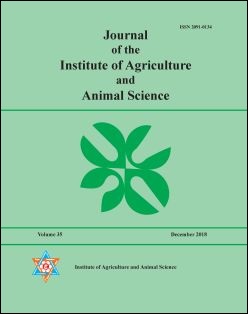Effect of Organic and Inorganic Sources of Nitrogen on Performance of Hybrid Potato Seed (HPS II/67) in Chitwan
DOI:
https://doi.org/10.3126/jiaas.v36i1.48418Keywords:
bio-fertilizer, True potato seed, seedling tuberAbstract
A field experiment was conducted at Meghauli, Chitwan to evaluate the effect of different levels of nitrogen (N) obtained from organic and inorganic sources on ware potato production from the first clonal generation of TPS hybrid (HPS II/67) during September, 2014 to February, 2015. The experiment was laid out in a randomized complete block design (RCBD) with nine treatments and three replications. The treatments consist of three different sources of nitrogen (Biomal, vermicompost and chemical fertilizers) having three different levels (80, 120 and 160 kg N/ha) from each source. Plant height, number of leaves/plant, total biomass/plant, total dry matter/plant and leaf area index were measured at 75 days after planting (DAP). Similarly, days to tuber initiation, number of tubers/plant, number of tubers/plot, tuber yield/plot and total tuber yield (mt/ha) were recorded. Cumulative physiological weight loss, greening percentage and sprouting percentage were observed during storage. B/C ratio of all the treatments were computed and compared. Experimental results revealed highest plant height (42.8cm), no. of leaves (145), biomass (98.9 gm/plant), dry matter (9.17 gm/plant) and leaf area index (3068.5 per plant) were recorded when 160kg N/ha applied through Biomal. The highest tuber yield (47.8 mt/ha) and B/C ratio (2.41) were obtained from Biomal at 160 kg N/ha. From this study, 160 kg N/ha from Biomal is recommended for higher productivity and economic returns for ware potato production from TPS hybrid (HPS II/67) under Meghauli, Chitwan, Nepal. However further study on different levels of N from organic sources is needed under different ecological niches.

